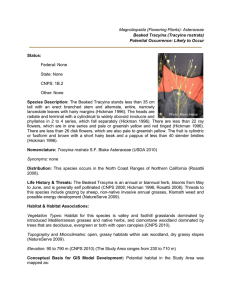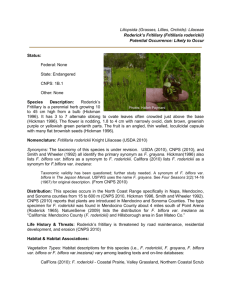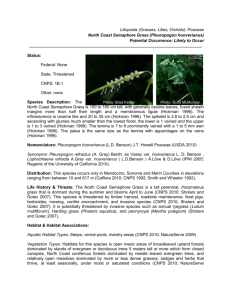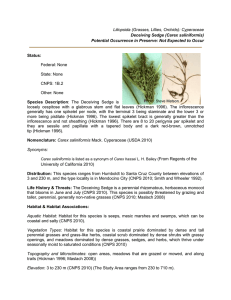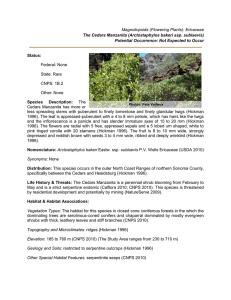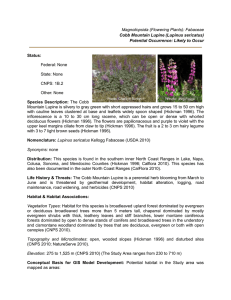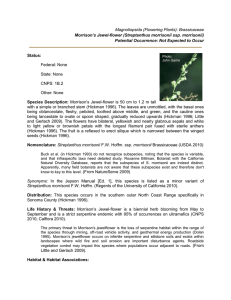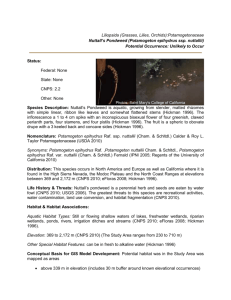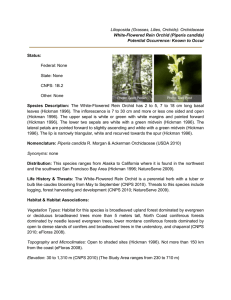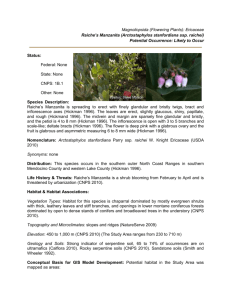JUHI Text
advertisement
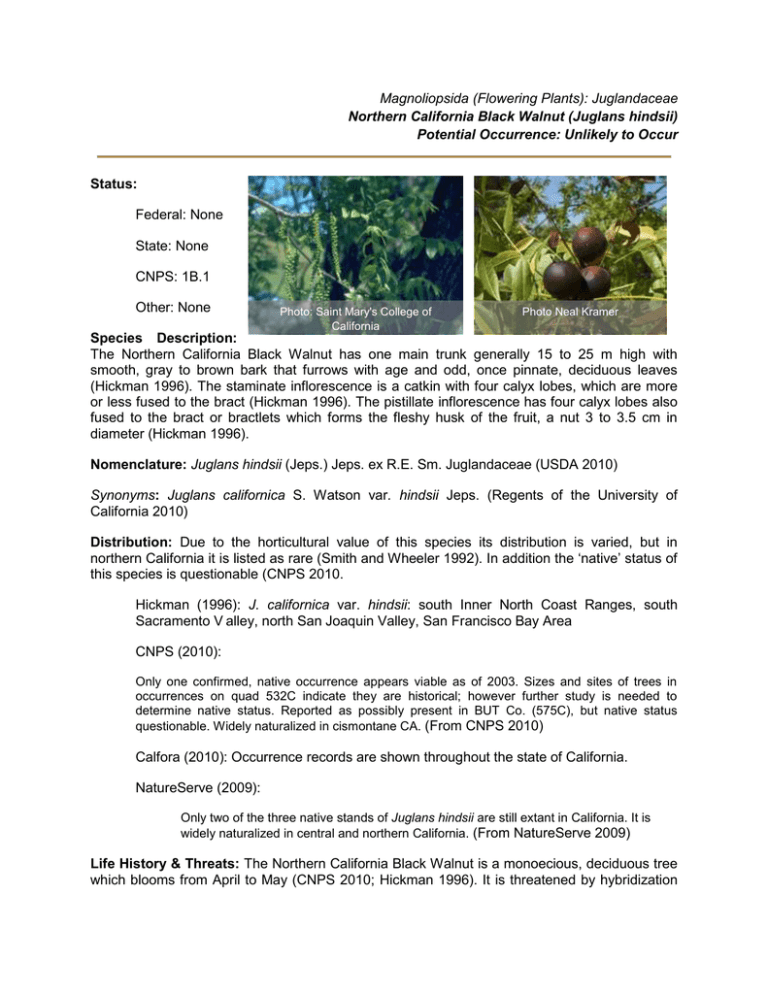
Magnoliopsida (Flowering Plants): Juglandaceae Northern California Black Walnut (Juglans hindsii) Potential Occurrence: Unlikely to Occur Status: Federal: None State: None CNPS: 1B.1 Other: None Photo: Saint Mary's College of California Photo Neal Kramer Species Description: The Northern California Black Walnut has one main trunk generally 15 to 25 m high with smooth, gray to brown bark that furrows with age and odd, once pinnate, deciduous leaves (Hickman 1996). The staminate inflorescence is a catkin with four calyx lobes, which are more or less fused to the bract (Hickman 1996). The pistillate inflorescence has four calyx lobes also fused to the bract or bractlets which forms the fleshy husk of the fruit, a nut 3 to 3.5 cm in diameter (Hickman 1996). Nomenclature: Juglans hindsii (Jeps.) Jeps. ex R.E. Sm. Juglandaceae (USDA 2010) Synonyms: Juglans californica S. Watson var. hindsii Jeps. (Regents of the University of California 2010) Distribution: Due to the horticultural value of this species its distribution is varied, but in northern California it is listed as rare (Smith and Wheeler 1992). In addition the ‘native’ status of this species is questionable (CNPS 2010. Hickman (1996): J. californica var. hindsii: south Inner North Coast Ranges, south Sacramento V alley, north San Joaquin Valley, San Francisco Bay Area CNPS (2010): Only one confirmed, native occurrence appears viable as of 2003. Sizes and sites of trees in occurrences on quad 532C indicate they are historical; however further study is needed to determine native status. Reported as possibly present in BUT Co. (575C), but native status questionable. Widely naturalized in cismontane CA. (From CNPS 2010) Calfora (2010): Occurrence records are shown throughout the state of California. NatureServe (2009): Only two of the three native stands of Juglans hindsii are still extant in California. It is widely naturalized in central and northern California. (From NatureServe 2009) Life History & Threats: The Northern California Black Walnut is a monoecious, deciduous tree which blooms from April to May (CNPS 2010; Hickman 1996). It is threatened by hybridization with orchard trees, urbanization, lack of reproduction, and conversion to agriculture (CNPS 2010; NatureServe 2009) Habitat & Habitat Associations: Aquatic Habitat Types: Along rivers and streams (NatureServe 2009). Vegetation Types: Habitat for this species is riparian forest dominated by broadleaved winter deciduous trees forming closed canopies and associated with perennial streams, and riparian woodland dominated by broadleaved winter deciduous trees with open canopies and associated with streams (CNPS 2010). Occasionally on somewhat drier slopes within foothill woodland and Yellow Pine forest communities (NatureServe 2009). Also found in wet meadows (Smith and Wheeler 1992). Topography and Microclimates: Canyons and Valleys (Hickman 1996) Given no specific additional requirements, grows especially well in zones 4, 5, 6, 7, 14, 15, 16, 17, 18, 19, 20, 21, 22, 23, and 24. Given moderate summer watering, grows in zones 8, 9, 10, and 11. (From Jepson Horticultural Database 2006) Elevation: 0 to 600 m (CNPS 2010; Smith and Wheeler 1992). (The Study Area ranges from 230 to 710 m in elevation). Geology and Soils: rocky, gravelly well drained soil (NatureServe 2010) Species Associations: Broadleaved riparian winter deciduous trees, Yellow Pine Forest (CNPS 2010; NatureServe 2009). Conceptual Basis for GIS Model Development: Suitable habitat in the Study Area was mapped as; below 630 m elevation (includes a 30 m buffer around known elevational occurrences for this species) riparian woodland and forest (i.e. Fremont cottonwood (Populus fremontii) and a 130-m buffer surrounding disjunct riparian vegetation along Rancheria Creek) foothill woodland (i.e. mixed, mixed montane or single dominant hardwoods with canopy cover < 40%). (Yellow pines do not occur in the Study Area). We additionally mapped possible best potential habitat in the areas identified above as: rocky soils (gravelly loam, cobbly loam or alluvium) well drained soil (drainage good or very good) Potential Occurrence on the Galbreath Wildlands Preserve: Habitat: Northern California Black Walnut occurs in well-developed winter-deciduous riparian woodlands and forests along perennial streams, and occasionally in cismontane woodlands. Habitat quality for this species within the Preserve is poor. Riparian vegetation is not found in areas with perennial water. The mainstem of Rancheria Creek is seasonal and riparian vegetation (woodland and scrub only) is patchily distributed along open erosional banks. Perennial streams draining into Rancheria Creek run through narrow canyons and are dominated by conifers and hardwoods which are not potential habitat for this species. Nearest Occurrence: Documented Occurrences on the Galbreath Wildlands Preserve: Previous species list for the Galbreath Wildlands Preserve did not document this species (SSU Field Station and Nature Preserves 2010). Nearest Occurrence to the Galbreath Wildlands Preserve This species is known from 4 occurrences in Mendocino County (Calflora 2010). The nearest occurrence is approximately 12 miles northeast from the Study Area on the U.C. Hopland Research and Extension Center in the Upper Russian River watershed (Calflora 2010). Distribution of this species is sparse often with great distances in between documented occurrences. Summary: Northern California Black Walnut is unlikely to occur on the Preserve because habitat quality is poor. References Calflora. 2010. Information on California plants for education, research and conservation.<http://www.calflora.org/>. Accessed 2010 Jun 25. California Native Plant Society (CNPS). 2010. Inventory of Rare and Endangered Plants. Online edition, v7-10b. <http://www.cnps.org/inventory>. Accessed 2010 Jun 25. Hickman JC editor. 1996. The Jepson Manual Higher Plants of California. 3rded.. London: University of California Press, Ltd. 709 p. Kramer N. 2009. Juglans hindsii. Northern California Walnut. < http://calphotos.berkeley.edu/cgi-bin/img_query?rel-taxon=contains&wheretaxon=Juglans+hindsii>. Accessed 2011 Feb 27. NatureServe. 2009. NatureServe Explorer: An online encyclopedia of life [web application]. Version 7.1. <http://www.natureserve.org/explorer>. Accessed 2010 Jun 25. Regents of the University of California. 2010. The Jepson Online Interchange California Floristics. <http://ucjeps.berkeley.edu/interchange/>. Accessed 2010 Jul 18. Saint Mary’s College of California.1995. Juglans hindsii. Northern California Walnut. < http://calphotos.berkeley.edu/cgi-bin/img_query?rel-taxon=contains&wheretaxon=Juglans+hindsii>. Accessed 2011 Feb 27. Smith GL, Wheeler CR. 1992. A flora of the Vascular Plants of Mendocino County, California. San Francisco: University of San Francisco. 120 p. SSU Field Stations and Nature Preserves. 2010. Galbreath Wildlands Preserve Vascular Plant List. <http://www.sonoma.edu/preserves/docs/galbreath_vascular_plants.pdf>. Accessed 2010 Jun. United States Department of Agriculture (USDA). 2010. PLANTS Profile. <http://plants.usda.gov/java/nameSearch?mode=symbol&keywordquery=JUHI>. Accessed 2010 Jul 18. Species Account Description: Linden Schneider
